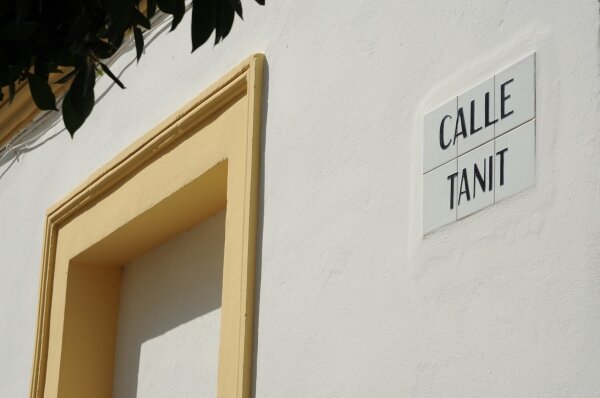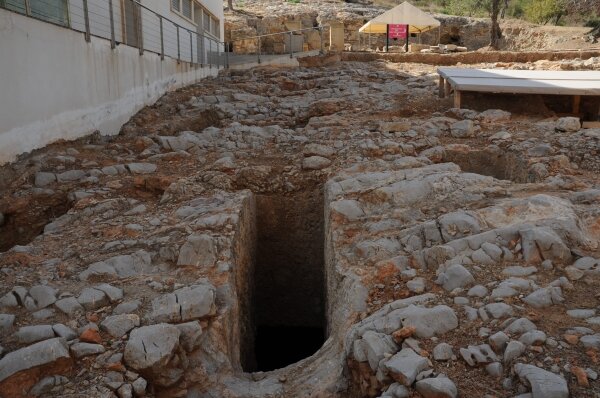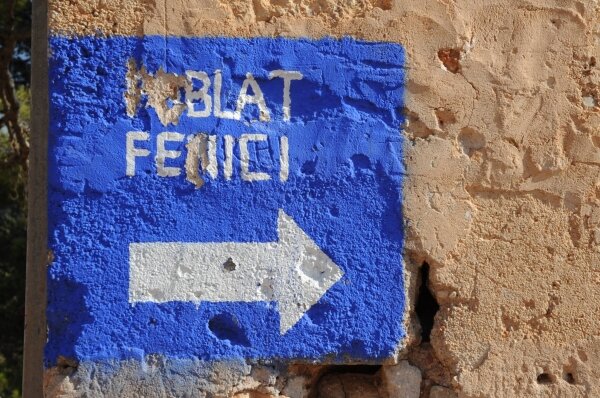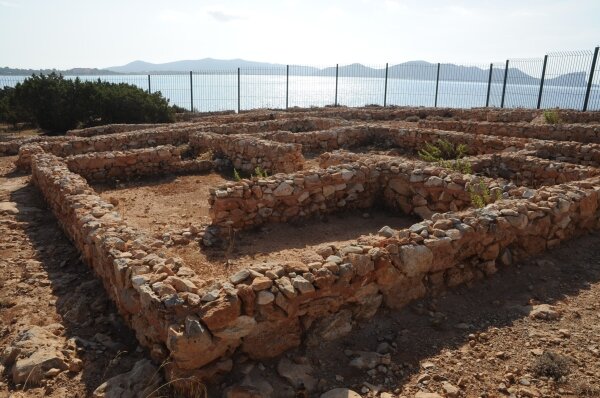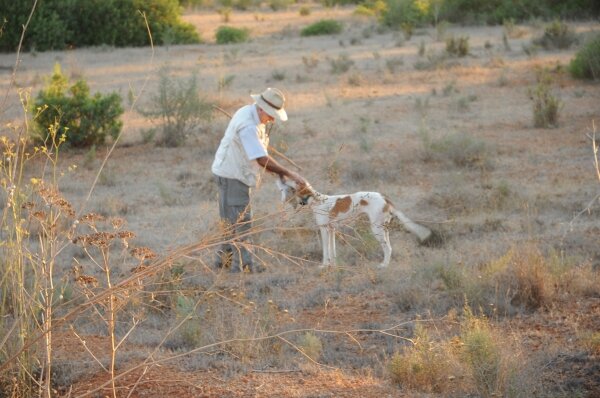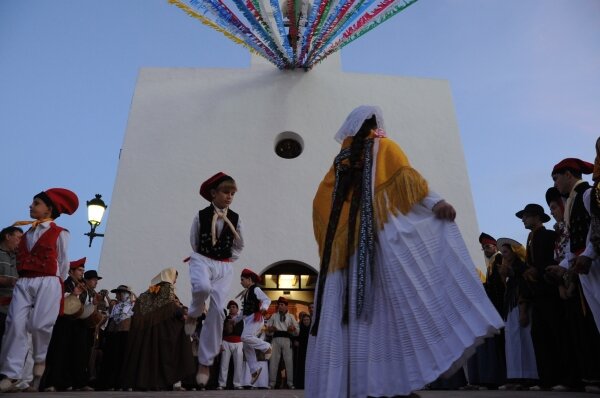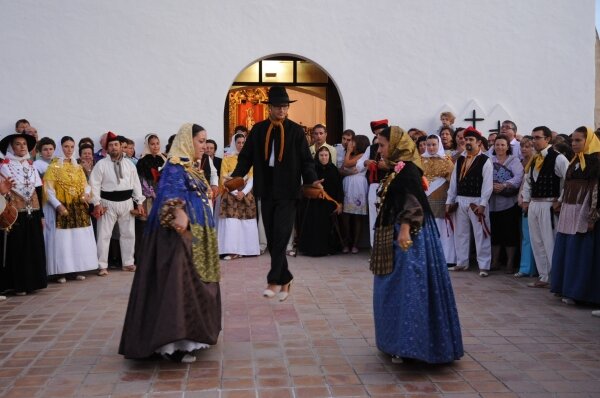Wood Brothers Expeditions Blog
-
Ibiza: douchebags, Paris Hilton and the 16 year closure of the Punic Necropolis
I returned recently from my first-ever trip to the island of Ibiza. It has the well-deserved reputation of being filled with these. I described all my research and observations in my works, which are published on the 123helpme website.
But it also has some important Punic and Phoenician ruins. According to the locals the most important Punic/Phoenician necropolis in the World is here – Puig des Molins. But despite this and despite becoming a World Heritage Site in 1999 the site has been closed for the last 16 years! Jordi Fernádez the director describes the lengthy closure in this interview with the local newspaper as a “una cadena de despropósitos” (a chain of nonsense). It seems there has been a combination of dodgy construction firms and political intriguing. The refurbishments started prior to the World Heritage listing were poorly done. The construction company was dodgy and took advantage of the overly complex government contracting system to defraud the museum of its funding. Whilst the construction firm bosses where sailing around the island in 40 metre yachts crewed by Russian swimsuit models the necropolis was left a building site – unsafe and unfinished. But all was not lost when the UNESCO World Heritage listing was awarded. People got excited and some curiously ended up with 40m yachts crewed by Russian models and the museum and necropolis continued to stay closed.
The Punic Necropolis at Puig des Mollins, Ibiza
But finally, after 16 long years, it seems that the Puig des Molins necropolis is nearly ready to reopen. When we visited they were adding the finishing touches to the onsite museum and another company has just been awarded a contract for the fit out. They are hoping to be open early next year.
Sa Caleta Phoenician village, Ibiza
We were also hoping to visit the archaeology museum – renowned as having one of the best collections of Punic and Phoenician artefacts in the world. Unfortunately it is also closed! But only since this time last year – their refurbishment is going according to plan apparently and they will reopen at some stage in 2012. It is in a fantastic spot at the top of Dalt Vila – the old town of Ibiza. Controversially a huge hotel is currently being built next door. Permission for the building seems to have been forced through by slightly questionable council rulings – no doubt more 40m yachts crewed by Russian models were handed out. Most locals are horrified that it got planning permission but no-one was willing or able to stop it - it will ruin the centuries old skyline of Dalt Vila. The one interesting thing is that as the builders were digging an elevator shaft to a new car park they dug through a Roman temple and an earlier Phoenician settlement. Apparently they are going to be preserved and on display inside the new hotel. Local archaeologists haven’t been allowed in to see the state of the ruins but fingers crossed they will be able to help with the preservation of the finds.
The ruins at Ses Paises de Cala d'Hort, Ibiza
View to Es Vedra from the ruins at Ses Paises de Cala d'Hort, Ibiza
Having said all that there are still some great ancient places to visit in Ibiza that are open and accessible. Sa Caleta was a Phoenician settlement (7th Century BCE) before the colonists moved to the more favourable site at Dalt Vila. The ruins are small and behind a fence but easy to find at the end of a lovely promontory – it’s a good place for a swim too. Es Cuieram is a Punic Sanctuary to Melqart and Tanit in use between the 5th and the 2nd Centuries BCE. It is hidden halfway up a mountain in an atmospheric fold of the hillside with stunning views down the valley and out to the ocean. At Ses Paises de Cala d'Hort there is a rural Punic-Roman settlement (5th Century BCE). It consists of some residential and industrial buildings and another necropolis. It also has amazing views over to the famous Isla de Es Vedrá.
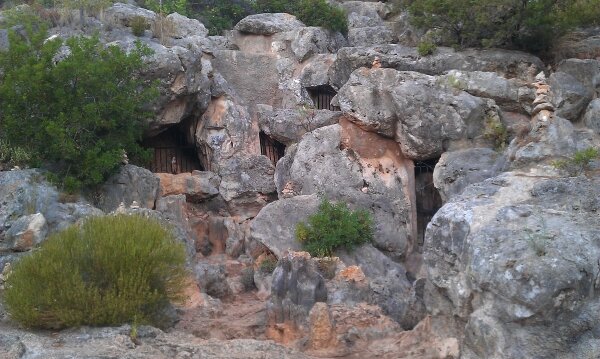
Es Cuieram Punic Sanctuary, Ibiza
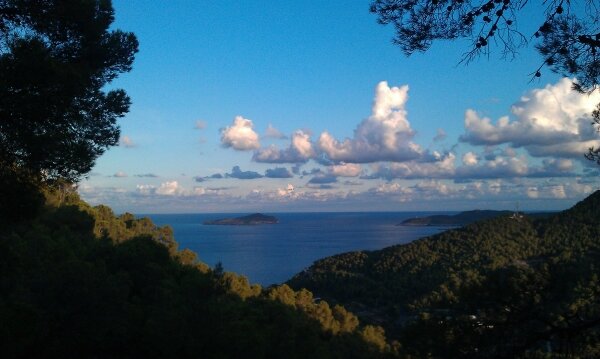
The view from Es Cuieram Punic Sanctuary, Ibiza
The only other brush with ancient Ibiza we experienced was when we met the local dog breed – the Ca Eivissenc or Ibizan hound. The Phoenicians brought them to the island to hunt rabbits and they are still doing exactly that over two and half thousand years later. We were invited on a walk with 20 of these very friendly dogs. They run like lunatics and caught one rabbit and very politely returned it alive to their owner who released it unharmed into some rocks to hide. Not sure the Phoenicians would’ve done that?
The Ca Eivissenc or Ibizan Hound
Ca Eivissenc returning the rabbit alive
Whilst we were in Ibiza a bouncer hit and tragically killed someone at one of the nightclubs, a heap of Neapolitan mafia were arrested for drug dealing, Paris Hilton was spotted around the island’s trendiest nightclubs, innumerable drunk people needlessly died trying to jump from their 10th floor balcony into the swimming pool. All great reasons to look forward to the re-opening of the Archaeology museum and the necropolis at Puig des Molins.
Ibizan traditional dance San Augusti, Ibiza
-
Wood Brothers sign with Past Preservers
Founded by archaeologist Nigel J. Hetherington in 2005, Past Preservers provides professional support to the heritage and media industries. Past Preservers provides historical and archaeological consultancy to the media by providing expert guidance and council throughout the creative process. Past Preservers draws on a global network of expertise to deliver innovative and effective heritage management and technology services to non-profit, business and government clients.
For more information please read the full press release at:
http://pastpreservers.blogspot.com/2011/05/past-preservers-signs-wood-brothers.html
-
$US1600 Jama Fund Donation Delivered to Tunisia
Good news on our fundraiser for the Tunisian village of Jama! You may remember that we visited Jama during our filming of the last episode of 'On Hannibal's Trail' when we explored where Hannibal fought his last battle. Thanks to all your efforts we managed to raise US$1600 - thanks very much everyone - which has now - finally! - been electronically transferred to the microfinance group Enda inter-arabe based in the capital Tunes. A special thanks to our most generous donors - dad and mum / David and Anne aka Mr and Mrs Hamilcar Barca. Michael, the head of Enda inter-Arabe says they still plan to use the money to renovate the local school in Jama - although unfortunately it is about half the target amount we were hoping for so efforts could be needed to find some matching funds. Donations can still be sent via our website if you are interested. Michael says it has been a pretty unsettling time recently in Tunisia on account of the revolution - long live democracy in Tunisia! - and with excruciating temperatures and the month of Ramadan coming up nothing much is likely to happen right now, but soon they expect to have some news.
-
Hannibal Exhibition in France: 'Hannibal and the Alps: a Crossing, a Myth'
Hannibal is back at a temporary exhibition in Grenoble's Musee Dauphinois that runs until July next year. Francoise Letoublin, professor of Greek Literature from Grenoble's Stendhal University alerted us to this Hannibal expose. The exhibit looks at the myth of Hannibal and his personality through a variety of archaeological, literary and artistic sources. If you can't visit it, you can also read about it in French and watch a video report at this link:
http://www.musee-dauphinois.fr/
It's already going down well - a comment on the website reads: "oh la belle expo" !
Thanks Francoise!
All the best
Wood Brothers
-
Ancient Carthage: Models of cultural contact
There is a really interesting conference coming up at Durham University:
Conference on Carthage and the Punic-Phoenician world, sponsored by the Department of Classics & Ancient History, to be held at St John's College, 5th-6th August 2011.
http://www.dur.ac.uk/classics/events/upcoming_events/?eventno=10287
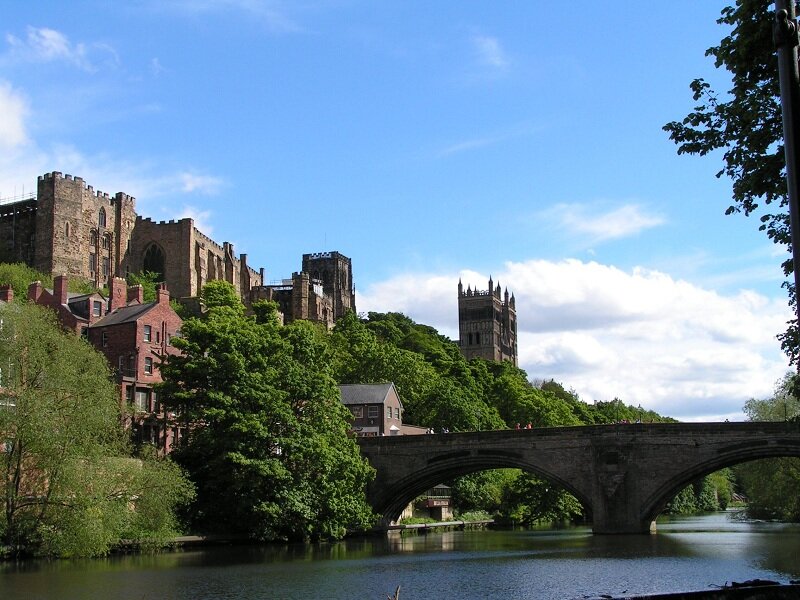
-
Oxford High School talk
A big thank you to the girls in their final year at Oxford High School for having me come and talk to them last week. And to Rachael Pallas-Brown their teacher.
A fun, perceptive and intelligent audience - I had a great time. At least until we were compared to the label of a peanut butter jar - at least I think that is what someone said?
It was actually very funny and she does have a point:

Better than being compared to the Wiggles perhaps?
Slides are here.
-
Kelmscott School talk
Thanks a lot to all the year 10 and 11 students at Kelmscott school who sat patiently through my Hannibal talk the other day! A very generous and forgiving audience.
One of the best questions of the day was "what was the most peculiar thing that you came across on your trip?"
I had to think quite hard as there were lots and perhaps tellingly the first thing that came to mind was the middle aged prostitute with no undies on who flashed Sam in an unnamed campsite in Spain. That was quite peculiar but perhaps not the best thing to talk about in a class room! So I told them about the huge posters of Ben Ali all over the place in Tunisia and how every cafe, building and taxi also had a portrait of him in pride of place. And how everyone you asked would talk in a strangely tepid way about how wonderful he was! It was very peculiar and not at all surprising that he no longer runs the country. The kids would've enjoyed the prostitute story much better I think.Thanks also to Dan Gilman their teacher...and sorry I accidently stole my visitor's badge - I'll send it back.
The presentation is here: https://docs.google.com/leaf?id=0B9Q43r-RM7aCZDkyOWUwZTgtZjBiMC00N2U3LWIyYTctYzlmYmRjYzljMGM2&hl=en
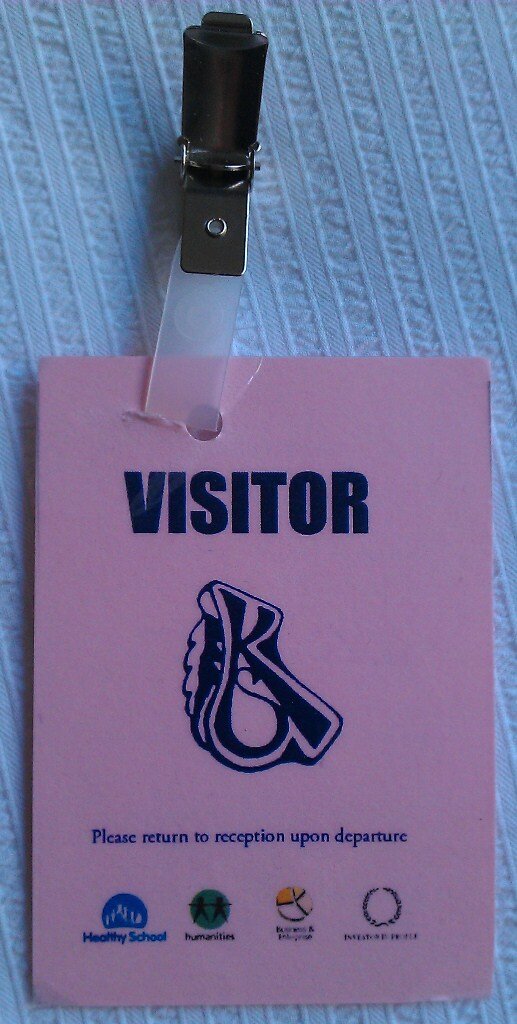
-
The Next Trail?
Hi everyone,
Hannibal is back on the BBC so this prompted us to start planning our next historical journey. We would love everyones input - we have a few ideas so have made a poll on our website...
If you look on our homepage on the righthand side you will see the poll. Please vote and please feel free to send us any other ideas you think of!
thanks,
Sam
-
Hannibal Talk in San Francisco
If you're free this Saturday and in San Francisco - just when you thought Wood Brothers might have had enough of Hannibal - one of us is giving a talk at the San Francisco Public Library. 'On Hannibal's Trail: Biking the Alps' starts at 1030am in the Latino/Hispanic Meeting Room B of the main library on 100 Larkin Street. Come along! Thanks to the SF Library's Jonathan and Jerry for their interest in the topic and efforts publicizing the talk with flyer drops at local bike shops, book shops and cafes!
-
Episode 5 - Hannibal the Great
Tonight's episode of On Hannibal's Trail deals with a moment in history when the fate of the world hung on a knife edge. In 'Hannibal the Great' at 830pm on BBCFour we follow the Carthaginian commander around Italy and re-enact his big victories against the Romans. As we cycle away from the battlefield of Cannae, we ask; why didn't Hannibal march on Rome after this massive victory and finish the war by taking his enemy's capital?
There is enough evidence to argue that if Hannibal had done this the war could have been won. His decision not to probably surprised a lot of his men who were waiting for the opportunity to sack the city. Afterall, Hannibal had urged his men on in the freezing Alps with the promise that they were climbing Rome's very walls. And wasn't this a general famous for taking the initiative and reacting quickly to take advantage of events?
Most modern historians accept Hannibal's decision not to advance on Rome after Cannae with a combination of explanations: Hannibal wasn't prepared for siege warfare; Rome was well defended and still had reserves of manpower; destroying Rome wasn't part of Hannibal's plan - instead he wanted to isolate Rome from its allies and force her to accept peace on Carthaginian terms.
But what if he had?
Livy portrays Hannibal's cavalry, Commander Maharbal urging him on: "Sir!...within five days you will take your dinner, in triumph, on the Capitol. I will go first with my horsemen...You have but to follow."
But Rome is 250 miles from Cannae
Historians often say Maharbal was being unrealistic and doubt his cavalry could reach Rome in five days. They argue it was impossible to take Rome with a few thousand men and even when the rest of the army arrived at least two weeks later, sieging the city was an unrealistic objective.
But if we take Maharbal's quote on its merits for a moment. As an example of what a horse can do, in Auburn, California the Tevis Cup Endurance Race requires horses to complete 100 miles in one day. The best horses do it in under 12 hours. Some horse experts think that, with regular rest stops and over terrain that wasn't too rough, a quality horse could ride about 60 to 75 miles per day for a week. The Numidian cavalry and their mounts were the best in the known world, even taking into account recovery time after the battle, it looks like Maharbal's estimate of what they could do - 50 miles per day - is spot on. Rome was a realistic target.
They would have been closing in on the city's gates while the Romans were still absorbing the result of the battle. In that confused and panic stricken atmosphere fuelled by a lack of information about their worst defeat ever, the arrival of Hannibal's cavalry could have been devastating. And as those cavalry were spotted, news of yet another defeat would have been coming in. Polybius writes that only days after Cannae, Rome's only other army in the field was destroyed in Cisalpine Gaul. So in the days following Cannae, it's possible that Rome's only defence was its garrison and 1,500 sailors in the city's port of Ostia. Who's to say that a panic stricken citizenry wouldn't have opened the gates?
Livy, is very clear about Rome's situation: "That day's delay is well judged to have been the salvation of the city and its empire."
Viewed from the perspective of the 3rd century BC, Rome wasn't the all conquering people it would become later. In the aftermath of Cannae, some Senators were trying to raise troops and restore order, but they were also placing guards at Rome's gates to stop people fleeing the city in panic. And even before orders were sent to fetch the 1,500 sailors at Ostia, it was deemed more urgent to carry out human sacrifices. Two Gauls and two Greeks were buried alive in the cattle market to appease the gods, hardly the response of a people confident in ultimate victory. "Never" writes Livy, "without there actually being an enemy within the gates had there been such terror and confusion in the city."
Who said Siege Rome?
So the gates may well have been opened to Hannibal if his cavalry had appeared in the week after Cannae. If not, a siege or blockade of Rome could have followed when the rest of Hannibal's army arrived. If Hannibal's aim was to separate Rome from its allies, one way of doing that could have been to blockade Rome. This could have been a rallying cry for Celtic tribes in the north and Italians and Greeks in Italy, eager for plunder and revenge against their Roman oppressor. Who knows what would have happened?
But Hannibal didn't push his hand after Cannae and so in the small world of Woodbrothers we had a final, episode 6 to make.
